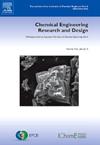CFD simulation of liquid-liquid extraction mechanism and enhancement schemes in microchannels based on three mass transfer models
IF 3.7
3区 工程技术
Q2 ENGINEERING, CHEMICAL
引用次数: 0
Abstract
Microreactors are highly efficient devices with a large specific surface area to improve the mass transfer efficiency. In this paper, a comprehensive three-dimensional CFD model was constructed based on three mass transfer theories to simulate the liquid-liquid two-phase flow and mass transfer process in a microchannel reactor, and two enhancement schemes were proposed. The multiphase flow and mass transfer characteristics were investigated by visualization and extraction experiments. The results indicated that the extraction efficiencies (E) and overall mass transfer coefficients () calculated by the penetration model and surface renewal model were within 15 % errors compared to the experimental values. Moreover, E primarily increases with the increase of fluid residence time, while increases with increasing flow rate. As the flow rate increases from 0.3 ml/min to 1.5 ml/min, E decreases by 15 %, and rises from 0.78 s⁻¹ to 2.65 s⁻¹. Whereas the channel width decreases from 0.8 mm to 0.3 mm, E decreases by 3 %, and rises from 0.44 s⁻¹ to 2.77 s⁻¹. Finally, microchannel with necked structure and baffles in mixing zone both improve the mass transfer efficient to some extent.
基于三种传质模型的微通道液-液萃取机理及强化方案的 CFD 仿真
微反应器是一种高效装置,具有较大的比表面积,可提高传质效率。本文基于三种传质理论构建了全面的三维 CFD 模型,模拟了微通道反应器中的液液两相流动和传质过程,并提出了两种增强方案。通过可视化和萃取实验研究了多相流动和传质特性。结果表明,渗透模型和表面更新模型计算出的萃取效率(E)和整体传质系数(KLa)与实验值相比,误差在 ±15 % 以内。此外,E 主要随流体停留时间的增加而增加,而 KLa 则随流速的增加而增加。当流速从 0.3 ml/min 增加到 1.5 ml/min 时,E 下降了 15%,KLa 从 0.78 s-¹ 增加到 2.65 s-¹。而通道宽度从 0.8 毫米减小到 0.3 毫米时,E 下降 3%,KLa 从 0.44 s-¹ 上升到 2.77 s-¹。最后,带颈结构的微通道和混合区的挡板都在一定程度上提高了传质效率。
本文章由计算机程序翻译,如有差异,请以英文原文为准。
求助全文
约1分钟内获得全文
求助全文
来源期刊

Chemical Engineering Research & Design
工程技术-工程:化工
CiteScore
6.10
自引率
7.70%
发文量
623
审稿时长
42 days
期刊介绍:
ChERD aims to be the principal international journal for publication of high quality, original papers in chemical engineering.
Papers showing how research results can be used in chemical engineering design, and accounts of experimental or theoretical research work bringing new perspectives to established principles, highlighting unsolved problems or indicating directions for future research, are particularly welcome. Contributions that deal with new developments in plant or processes and that can be given quantitative expression are encouraged. The journal is especially interested in papers that extend the boundaries of traditional chemical engineering.
 求助内容:
求助内容: 应助结果提醒方式:
应助结果提醒方式:


